

Now playing:
Watch this:
Samsung Smart Remote: Hands-on with the best TV clicker…
3:02
I’m the first to argue that a buying a TV should be about the combination of picture quality and value first, and everything else second. The remote included with that TV should be placed pretty far down the list of priorities.
That said, the remote you use to control your TV and other gear is important. It sees constant use, especially if you do a lot of DVRing or perform other interactions beyond watching passively, and ideally it should be as simple as possible, intuitive and ergonomic.
Samsung’s 2014 Smart Remote is all of those things and more, making it the best remote I’ve ever used on a TV. That doesn’t mean I recommend it over a good universal remote, especially for power users with lots of extra gear they want to command from one clicker. But if you have a simple system — the TV, cable box/DVR. and maybe a sound bar and Blu-ray player — it works better than any included clicker at controlling it all, and can even make the process kinda fun.
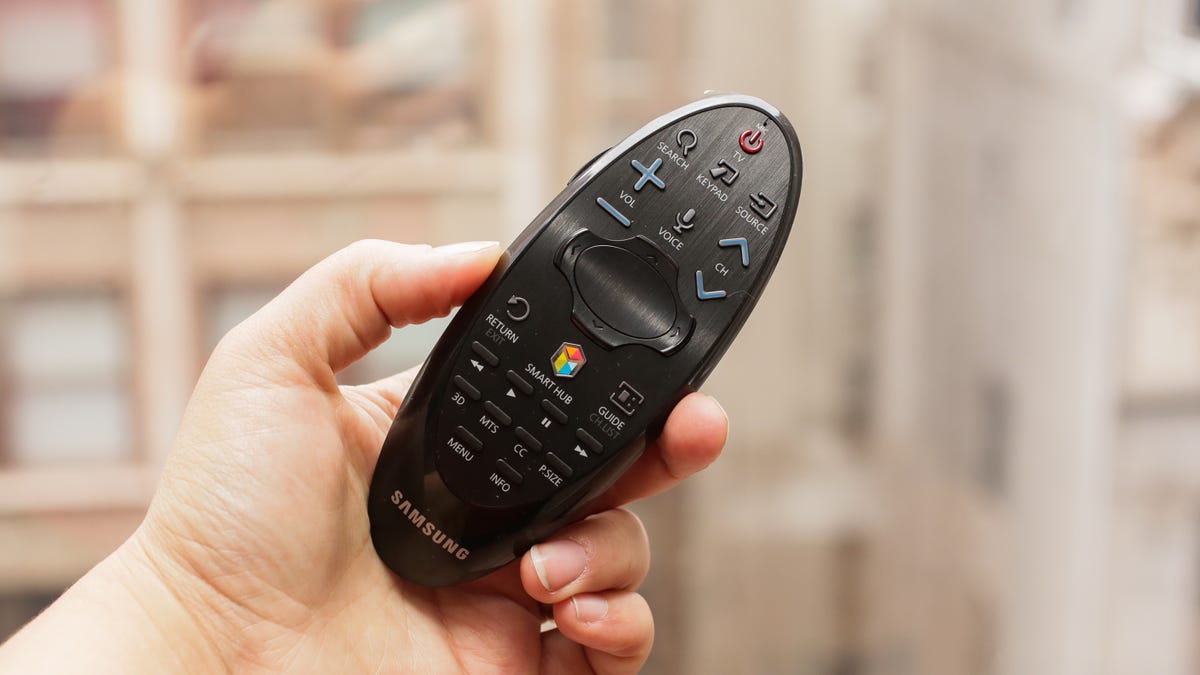
Sarah Tew/CNET
Before I get into the nitty gritty, know that most of the following is excerpted from my recent review of the Samsung UNH6400 series , the cheapest of the company’s TVs to include the new remote. Step-down models from the UNH6350 on down have a standard multibutton clicker.
My comments also apply to other Samsung TVs that have the remote, although higher-end TVs get the silver (as opposed to all-black) version, as well as a dedicated key for the Multi-Link (fancier picture-in-picture) function. Button configurations and capabilities will also vary for non-US markets. The Australian version, for example, has a dedicated Soccer button. Don’t ask me what it does.
Motion control for the win
For the last few years I’ve been very impressed by LG’s motion remotes, which behaved a lot like a Nintendo Wii controller. You control a cursor by waving the remote at the screen, and once you get the hang of it, navigation can happen more easily and efficiently than with the standard method of clicking from one selection to the next, especially on a large screen with a lot of icons.
Much like touchscreens seem the ideal interface for phones and tablets, and a touchpad or mouse rules the PC screen, a motion controller provides (in my experience) the best control over a lean-back Smart TV interface.
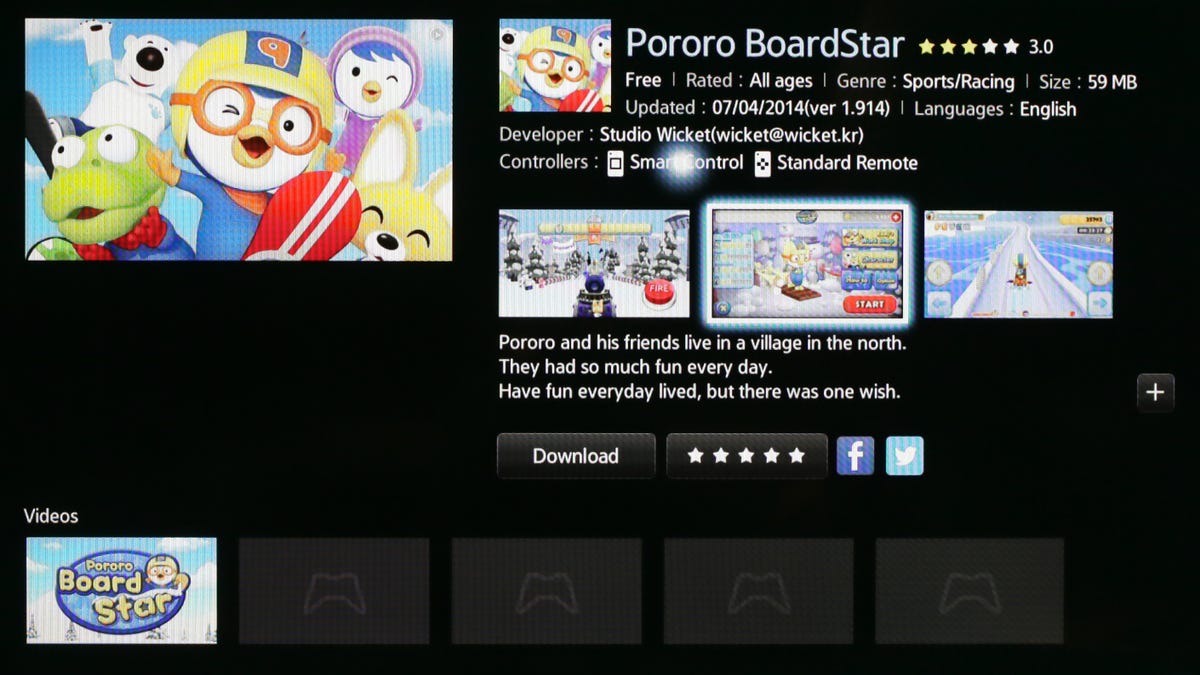

Sarah Tew
This year Samsung copied LG’s idea and then improved upon it. Like LG’s system, Samsung’s motion remote is remarkably precise and makes navigation of most menus and selections — especially the browser, and the onscreen, virtual remote and keyboard — swift and even kinda fun.
But one flaw in LG’s design is the need to occasionally shake the wand to activate the cursor. On Samsung’s new remote, simply resting your thumb on the little concave touchpad wakes up motion control and summons the cursor. Conversely, removing it from the pad deactivates the functionality. It’s a remarkably simple arrangement that takes about 10 seconds to assimilate and works beautifully in practice.
Unlike the kind found on a laptop or some other remotes, that little touchpad isn’t used to move the cursor at all. Its only other major functions are to enable scrolling, particularly on the Web browser, and to serve as the main “OK” or “Select” command with a downward click, which feels sort of like a mouse button.
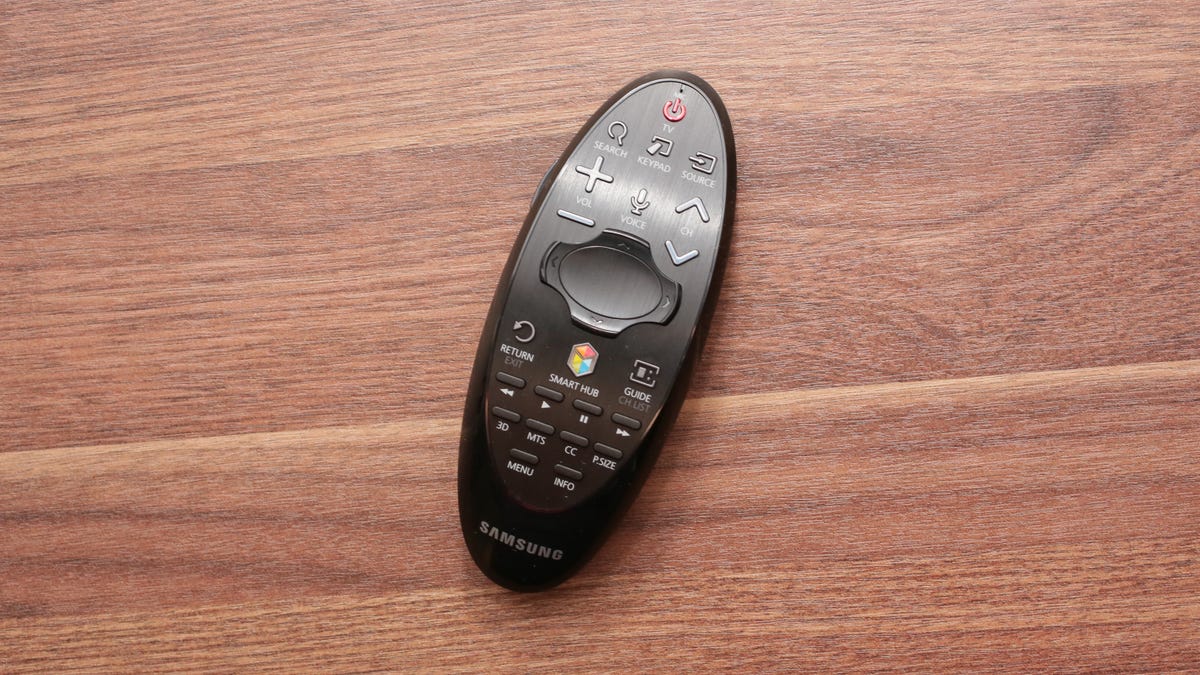

Sarah Tew/CNET
I loved the vibe of the small-but-not-too-small Smart Remote, especially its subtly curved shape and ribbed backside. Every key lives within easy thumb-reach, and for those apps and menus that don’t support motion control, you drive between selections with a standard four-way cursor placed around the edges of the pad. The touch-to-activate-motion system is a boon here too, because menus that don’t support touch become instantly recognizable: if the little motion cursor doesn’t appear at your touch, it’s time to resort to the four-way keys.
Like many new remotes the Smart Control uses Bluetooth to communicate with the TV, so you don’t need line-of-sight or even to aim it at the television for it to work.
Button balancing act
As usual Samsung sacrificed a bunch of direct-access keys available on its traditional clicker to make the Smart Remote smaller and more ergonomic. Major ones include the numeric keypad, a few set-top box controls, and the Tools shortcut menu.
I did appreciate that dedicated transport keys (play, pause, fast-forward and rewind) are present on the Smart Remote. This addition alone makes it superior to LG’s 2014 remote, which makes you resort to a menu for those functions.
On the other hand I wondered why Samsung elected to include the less-useful “MTS” and “CC” keys. I’d much rather get forward/reverse skip, or even “STB Menu” and “DVR” for cable box control. I was also miffed at the remote’s lack of backlighting.
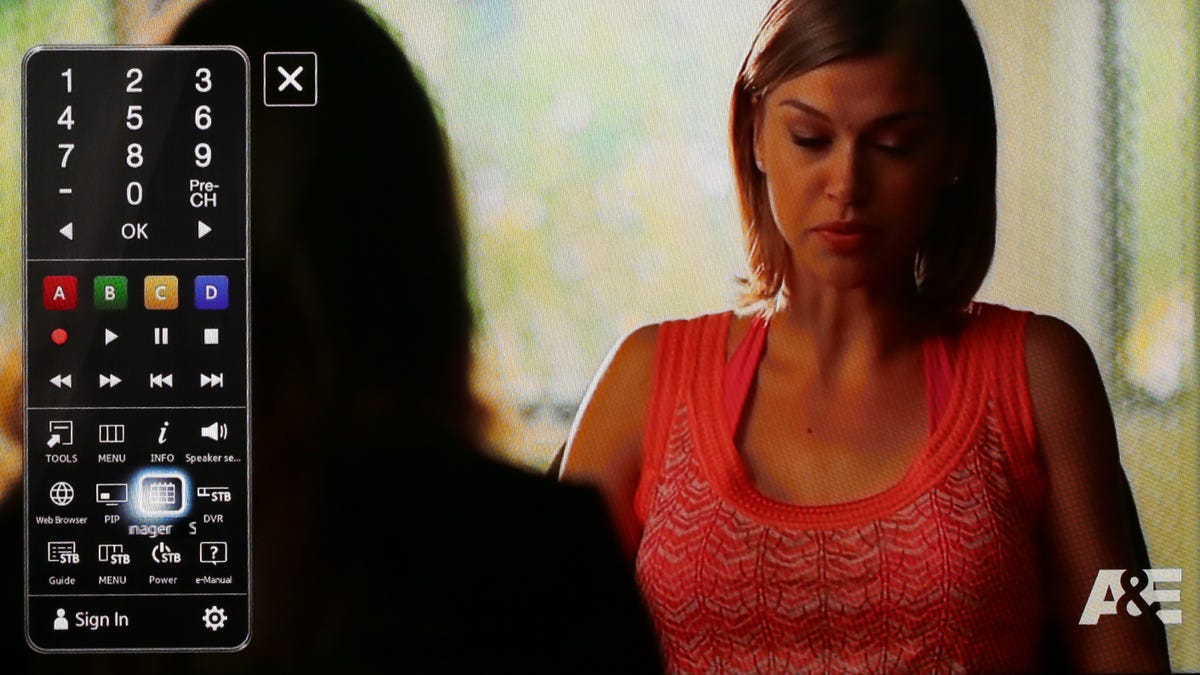

Sarah Tew/CNET
Commands that aren’t granted a dedicated key are available via an onscreen remote, which pops up when you press the Smart Remote’s “Keypad” button. It’s more of a pain than direct-access keys, but a heck of a lot easier than on Samsung’s 2013 TVs , thanks to motion control. How much of a pain depends on what you want to do; if you frequently type in channel numbers directly, for example, that virtual numeric keypad might soon become your hated nemesis.
Sorta-universal control of other devices
Beyond great ergonomics and the ability to command the TV’s many functions itself, a good remote should also be able to control other gear. The Smart Remote can, although it doesn’t work as well as my favorite Logitech.
Since the Smart Remote relies on Bluetooth between itself and the TV, infrared commands for other gear are transmitted from the TV to the rest of your entertainment system through the included IR blaster (below).


Sarah Tew/CNET
I didn’t like the system quite as much in practice as I did LG’s system from 2013 , which is being largely carried over this year. That’s because LG’s remote sends the IR commands itself, without needing an external blaster. On the other hand, Samsung it roundly beats Sony’s 2014 system.
When controlling the cable box, the very slight delay between pressing a button and seeing the results onscreen was almost unnoticeable; the H6400 seemed seemed faster than on the H6350. That said it’s still not as responsive as direct control via a universal or included cable box remote, especially when moving around the box’s guide or menus.
If you do decide to use the TV to control your cable box, you’ll find yourself visiting the onscreen remote a lot. As I mentioned it’s better than Samsung’s previous version, thanks to the ability to select and press the onscreen “keys” much more quickly than before, but it can’t hold a candle to a good universal remote.
Accessing my list of recorded shows on the DVR was especially tedious. I had to press “Keypad” (which summons the virtual remote), then use the motion control select the “STB Menu” virtual key (the virtual key marked “DVR” didn’t work), then use the four-way cursor to click down to “DVR,” and then over to “View Recordings.” Compare that to one press of the “DVR” button on a standard remote. For some reason the “Return” key also failed with my DVR, and I was annoyed that the Guide button summoned Samsung’s own, not the one on my cable box.
Beyond a cable box, Samsung’s system can control a Blu-ray player and a Home Theater System. I set it up for a Sony HT-CT770 sound bar and a Panasonic DMP-BDT350 and it worked well with both. When I played a Blu-ray, the volume and mute commands were passed through the sound bar (I had to disable the TV’s speakers, as instructed) and the transport functions worked well for the player.
It’s not perfect however. The sound bar didn’t react to a command labeled “sound mode” on the virtual remote, the “pop-up menu” command instead engaged the Top Menu function (I know, right?!), and there’s no command for “Eject.” It’s also worth noting that Samsung’s system couldn’t find the exact model of my sound bar–luckily, when I selected the model that seemed closest, the major functions worked.
All of which goes to show that any control scheme is only as good as the commands included, and if it can’t “learn” new or custom commands, more’s the pity. Samsung’s cannot, so if your device or command isn’t available, you’re out of luck.
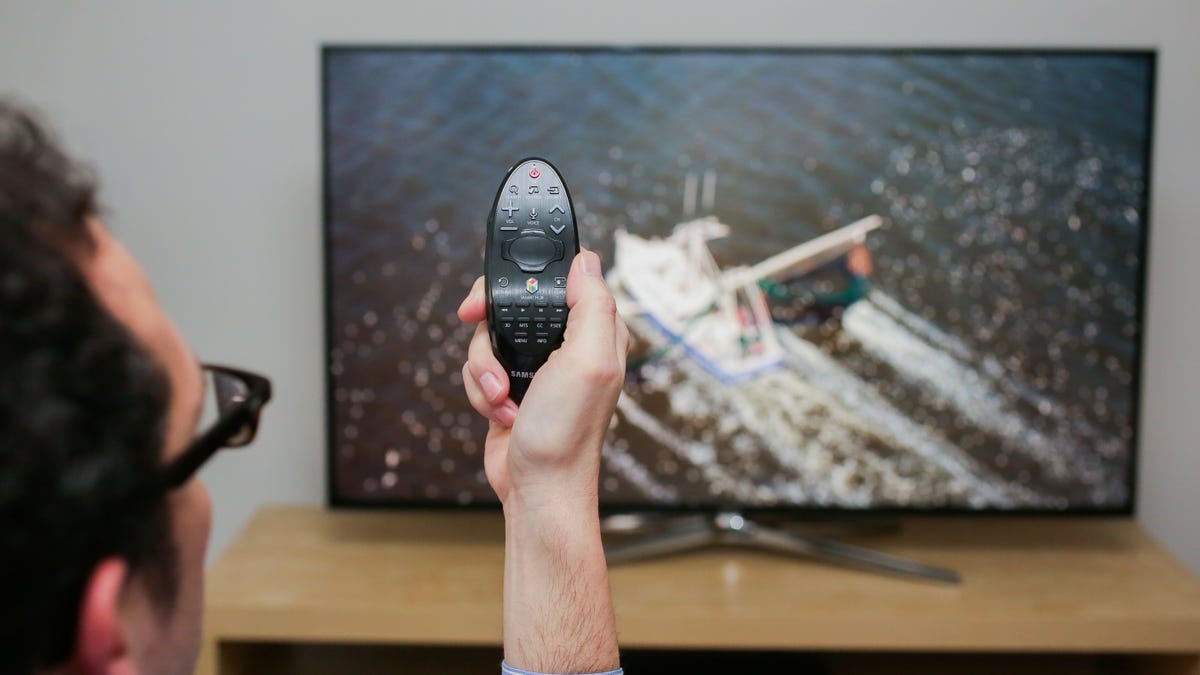

Sarah Tew/CNET
Bottom line: Works best with simpler systems
For me, despite it being the best remote I’ve ever seen included with a TV, Samsung’s Smart Remote would still be relegated to a drawer somewhere in favor of my Logitech Harmony Smart Control. If you’re like me, remotes on your coffee table are like immortals in “Highlander“: There can be only one.
While the Smart Control has its advantages, the Logitech is simply better at controlling multiple devices. Beyond my home theater system and Blu-ray player I have other devices I need controlled (like my Roku and game console), and I demand more customization than Samsung’s remote offers. I also need dedicated forward and reverse skip buttons for skipping commercials on my DVR, and I’d become annoyed at the need to frequently access the onscreen remote to control my cable box.
That said, on a simpler system or with a someone who’s more inclined to use the Samsung TV for most activities and apps, as opposed to external devices, the Smart Remote could easily render a universal clicker obsolete. And that’s more than I can say for any previous remote included with a TV.




